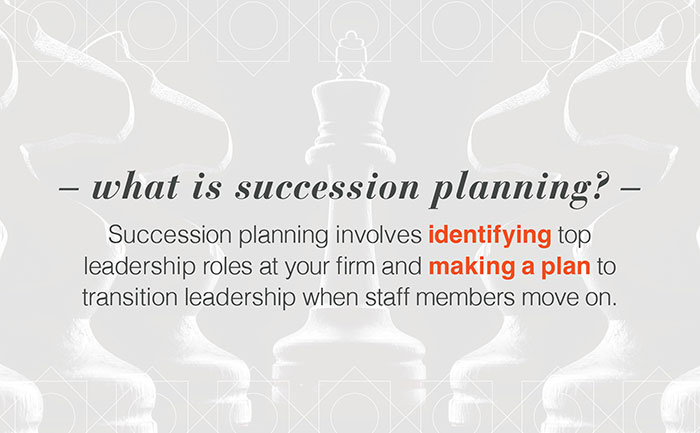Many financial advisor professionals in the U.S. are nearing retirement, nearly 40% of the industry headcount, according to a survey conducted by Cerulli Associates; making succession planning as important as ever for firms looking to maintain success for generations to come.
Succession planning involves identifying top leadership roles at your firm and making a plan to transition leadership when staff members move on. Succession planning helps ensure that all of your hard work endures past your tenure.
Succession planning also involves replacing other talented members of your firm, not just those at the top. From planned employee retirements to unexpected departures, having a plan in place will make the transition process for each position much smoother.

How can ownership be transferred?
Ownership of your firm can be transferred to an individual(s) from within your company, or an outside organization/individual(s). Upholding the vision you created, your successor could be anyone from family members or employees to a strategic or financial buyer.
Transferring ownership to individuals or organizations outside your firm can be accomplished through:
- Private Equity, which transfers ownership to a group of investors, creating a liquidity event for the current owner(s) while simultaneously providing expertise for the future of the firm
- Initial Public Offering (IPO) by offering shares of your private firm to the general public in a new stock issuance
- Or, a strategic buyer, which transfers complete ownership to an individual outside of your firm, or a competitor, opening new opportunities to create a more powerful entity
Transferring ownership to individuals within your firm can be accomplished through:
- A management buy-out, which allows your firm’s management team to purchase the business they manage and are deeply familiar with
- A complete ownership transfer by the gifting of shares or sale of your firm to a family member or business partner
- An Employee Stock Ownership Plan (ESOP) gives stock ownership to employees through the establishment of a trust. This ownership structure connects your company's employees to its long-term success and allows for the possibility of the transitioning owner to remain involved in a leadership role.
What should I consider prior to selling my firm?
Understand what each employee brings to the firm and their goals. Maintain open communication with your firm’s top talent so you can know far in advance their goals and retirement plans. Run through the hypotheticals. Take note of what each of your top employees brings to the table so that you know exactly what to look for in a suitable successor, whether it’s an internal promotion or an external hire.
Developing tomorrow’s leaders. It can be easy to identify a talented employee, but it’s not always as easy to ensure that top talent is being developed. At all levels of your firm, implement career and professional development programs that staff can use to grow from the beginning of their time working for you. This investment in your employees will benefit your firm in the short-term, and make your succession plans easier when the time comes to transition leadership.
If you’ve identified talent worthy of succeeding yourself or another leadership position, don’t hesitate to communicate that with individual(s) you have in mind. Letting them know these plans could motivate talent to stay around and remind them of their value to the firm, in addition to being an important part of the professional development process.
Have the right partnerships in place. Regularly discuss and evaluate your succession plan and exit strategy with your attorneys, accountants, and bankers. The sale of your firm, regardless of approach, must be well documented for tax implications and bank covenants. In addition, an experienced investment banker or business broker can also help facilitate the sale of your company, offering inside knowledge to potential buyers.
Future cash flow. In advance of creating an exit strategy, cash flow needs to be considered for both the exiting owner and the buyer's needs. Depending on how your firm is sold, owners may have an outstanding seller note for several years. Aligning your company’s future capital requirements as well as your own with its current profitability can ensure a sustainable exit strategy.
Market value. Business valuations by an experienced professional can inform your decision to sell and prepare you for opportunities when market forces are most favorable. Keep in mind, there are multiple approaches to valuing a firm, so a final purchase price will most often require negotiation.
A strategic plan for succession and an exit strategy begins well in advance of an owner’s exit, encompassing business valuation, negotiation, funding arrangements, successor designation, and time to review and adapt the plan as new situations arise.



